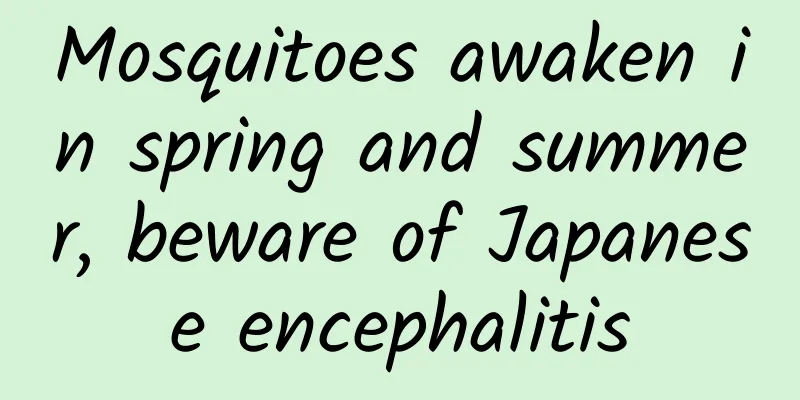Mosquitoes awaken in spring and summer, beware of Japanese encephalitis

|
Mosquitoes awaken in spring and summer, beware of Japanese encephalitis Recently, two cases of Japanese encephalitis were reported in Taiwan Province of my country, and one person died. Many people may wonder how there is a new Japanese encephalitis? In fact, if we change the name, it will become familiar. Japanese encephalitis is another name for epidemic Japanese meningitis, abbreviated as Japanese encephalitis virus. It was first isolated by Japanese scholars in 1935 and is known internationally as Japanese encephalitis. So what does the Japanese encephalitis virus look like? Japanese encephalitis virus is a member of the Flaviviridae family. The virus particle is spherical, with a diameter of 45-50nm. The nucleocapsid is icosahedral and has an envelope with glycoprotein spikes. The viral nucleic acid is a single positive-strand RNA, and the genome is about 11kp long. The three structural proteins encoded by the viral genome are capsid protein (C protein), pre-membrane protein (prM protein) and envelope protein (E protein). C protein is an alkaline protein rich in arginine and lysine, and plays an important role in the replication, transcription regulation, assembly and release of the virus. prM protein is only present on the envelope of immature virus particles. E protein is a glycosylated protein embedded in the viral envelope, which is closely related to the adsorption, penetration and pathogenicity of the virus. The antigenicity of Japanese encephalitis virus is stable, with only one serotype. No obvious antigenic variation was found between isolates from different years in the same region, and there was no obvious difference between isolates from different regions and at different times. According to the homology of the full sequence of the E gene, Japanese encephalitis virus can be divided into 5 genotypes (I, II, III, IV and V), and each genotype has a strong cross-immune protection effect. The distribution of genotypes is regional to a certain extent, and the main genotypes prevalent in my country are genotypes I and III. It looks very complicated, so how is it cultivated? Japanese encephalitis virus can proliferate and cause obvious cytopathic effects in various passage and primary cells such as Aedes albopictus C6/36 cells, Vero cells and BHK21 cells. Among them, C6/36 cells are the most sensitive cells to Japanese encephalitis virus and are widely used for virus isolation and culture. Suckling mice are the most susceptible animals. How does it spread in the infection? The main sources of infection of Japanese encephalitis virus are livestock, poultry and various birds such as pigs, cattle, sheep, horses, donkeys, ducks, geese and chickens that carry the virus. In my country, pigs are the most important source of infection and intermediate hosts, especially piglets born in the same year. Due to lack of immunity, they have a high infection rate and high titer of viremia. Breeders and people around them can be infected due to high frequency of contact with the virus. Usually, the peak infection period of pigs is about 3 weeks earlier than the peak incidence period of the human population. Therefore, the epidemic trend of the year can be predicted by checking the infection rate of pigs. Humans are the terminal hosts in the transmission chain of Japanese encephalitis. Infected mosquitoes can carry the virus over the winter and can pass it on through eggs, so mosquitoes are both a transmission medium and an important storage host. With the support of the host, the Japanese encephalitis virus becomes rampant. The main vector of Japanese encephalitis virus is Culex tritaeniorhynchus. In addition, Culex pipiens, Aedes albopictus, Culex twotaeniorhynchus, Culex snowbacked, Anopheles sinensis, etc. can also carry the virus. In addition to mosquitoes, Japanese encephalitis virus has also been isolated from midges, midges and Culicoides. Therefore, these insects may also be the vectors of Japanese encephalitis virus. After the mosquito sucks blood, the virus first proliferates in the epithelial cells of the midgut, then enters the salivary glands through the blood cavity, and is transmitted by biting susceptible animals such as pigs, cattle, sheep, horses and other livestock or poultry. The virus forms a natural cycle from animal to mosquito and animal to animal through mosquitoes. During this period, the virus-carrying mosquitoes bite humans, which can cause human infection. So what is the pathogenicity of the Japanese encephalitis virus and why is it so lethal? After the virus enters the human body through the bite of an infected mosquito, it first proliferates in the Langerhans cells, macrophages and local lymph nodes of the skin, and enters the bloodstream through capillaries and lymphatic vessels, causing the first viremia. The virus spreads through the bloodstream to the mononuclear-macrophages in the liver, spleen, etc., continues to proliferate in large numbers, and enters the blood again, causing the second viremia, which is clinically manifested as flu-like symptoms such as fever, headache, chills, and general discomfort. The vast majority of infected people no longer develop their condition and become aborted infections. However, in a small number of infected people with weak immunity, the virus can break through the blood-brain barrier and invade the central nervous system, proliferate in the nerve cells of brain tissue, cause nerve cell degeneration, necrosis, inflammation of brain parenchyma and meninges, and central nervous system symptoms and signs, such as high fever, headache, impaired consciousness, convulsions and meningeal irritation signs, etc. In severe cases, it can further develop into coma, central respiratory failure or brain herniation, and the mortality rate can be as high as 10%-30%. About 5%-20% of survivors have sequelae, manifested as dementia, aphasia, paralysis and mental disorders, etc. If infected in the first or second month of pregnancy, it may cause stillbirth and miscarriage. It can be seen that the mortality rate is not low among severe cases, so how can it be prevented and treated? Key measures to prevent Japanese encephalitis include vaccination, mosquito prevention and control, and animal host management. There are two major types of Japanese encephalitis vaccines: inactivated vaccines and live attenuated vaccines. The Japanese encephalitis vaccines widely used internationally are mainly purified inactivated vaccines from mouse brain. Since 1968, my country has used inactivated vaccines cultured from hamster kidney cells to carry out planned immunization for children, which has achieved remarkable results and effectively controlled the prevalence of Japanese encephalitis. SA14-14-2, a live attenuated Japanese encephalitis vaccine successfully developed in my country in 1988, has good safety and immune protection effects. It has become the main vaccine for preventing Japanese encephalitis in my country and is currently the only live attenuated Japanese encephalitis vaccine used in humans. Pigs are the main source of infection and intermediate host of Japanese encephalitis virus. Therefore, the incidence rate of the population can be reduced by doing a good job in pig management or immunizing pigs. At present, there is no specific treatment for Japanese encephalitis. It can be seen that Japanese encephalitis is a disease that is more important to prevent than to cure. Spring and summer are breeding grounds for mosquitoes. At this time, we should learn more about the Japanese encephalitis virus in order to improve our awareness of prevention and become our own safety guard. References in this article are from the ninth edition of Medical Microbiology |
>>: Things you shouldn’t hide from your anesthesiologist before surgery
Recommend
How to prevent and treat painful urination
If there is stinging and burning sensation when u...
What is the largest pyramid in Egypt? In which city are the pyramids in Egypt located?
The Egyptian pyramids are the tombs of the ancien...
How long does the egg survive after ovulation and what symptoms will occur when it is released?
If female friends want to get pregnant, they must...
What causes oral ulcers? There are these reasons
I believe that many people in life have suffered ...
How much does it cost to do a sugar screening? How much does it cost to do a Down syndrome screening?
When preparing for pregnancy, you need to do a pr...
Do women snore, too? And more than men? The reason is revealed!
Audit expert: Wu Xi Associate Chief Physician, De...
What is the reason for discomfort during sex?
Sexual life is supposed to be pleasant and relaxi...
Can I eat oranges during my period?
Women’s diet during menstruation is very importan...
[Medical Q&A] Do you know the correct way to sunbathe?
Author: Huang Zijuan Affiliated Hospital of South...
When guests arrive, the heart is always warm, and when guests leave, the tea is still hot - drinking 2-3 cups of tea a day can significantly reduce the risk of venous thromboembolism. You can add milk, but never sugar.
Venous thromboembolism (VTE), including deep vein...
Treatment of Amenorrhea Based on Syndrome Differentiation in Traditional Chinese Medicine
If a woman has symptoms of amenorrhea, she must u...
Will I still have my period after I get pregnant?
People will stop having their periods after they ...
Do women need to take off their underwear for MRI?
Magnetic resonance imaging is needed when examini...
How long after cesarean section can I have a second child?
Many women do not know much about fertility, such...
Signs of strong sexual desire in girls
For male friends, everyone knows how to judge sex...









